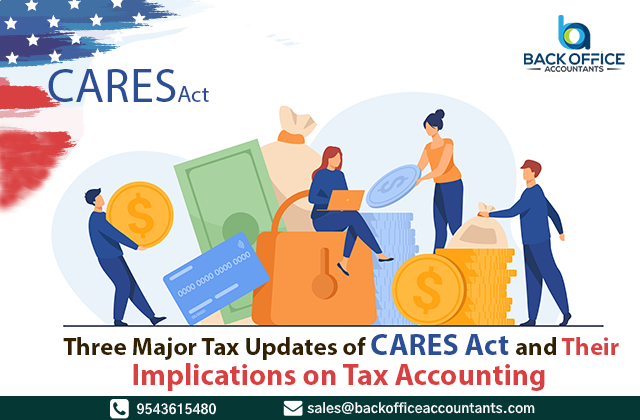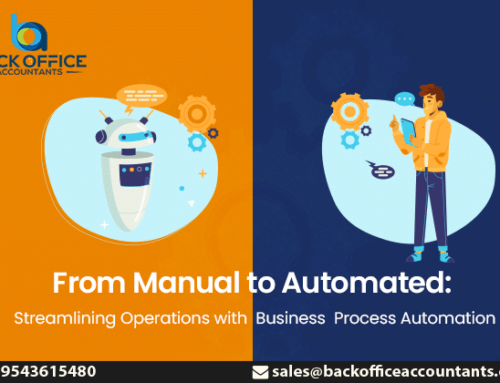On March 27 this year Congress passed and President Donald Trump has signed the Coronavirus Aid, Relief, and Economic Security Act (CARES Act) that is aimed to address the economic fallout set on motion by the COVID-19 pandemic in US.
This massive $2 trillion economic relief package comprises a slew of stimulus measures, business incentives & economic provisions. The Act also made a few changes to the federal tax laws and these new tax updates can have an immediate impact on taxes and financial statements of businesses in US.
This piece today focuses on three major tax updates of this CARES Act and their implications on tax accounting:
1. A Five-year Carryback of NOLs Generated in 2020, 2019 & 2018:
Under the pre-CARES Act which is Tax Cuts and Jobs Act (TCJA), businesses were prohibited from carrying back the Net Operating Losses generated after Dec 31, 2017, but were allowed to carry them forward indefinitely. Moreover, under this law, NOLs can be used to offset only 80% of the taxable income. But the CARES Act had made a major revamp to these tax provisions to help businesses generate cash flows using tax refunds.
Under the CARES Act, all the Net Operating Losses generated in 2018, 2019, and 2020 can be carried back by five years. And this applies to all the businesses except the entities which qualify as real estate investment trusts. In addition to this, the CARES Act also enables businesses to offset 100% of taxable income with the generated Net Operating Losses. Given the tax rates in 2017 were higher than in 2018, this provision can create a good cash flow for the business during this pandemic. As this extension on carryback of Net Operation Losses can impact the calculation of taxes, businesses must assess and consider tax effects carefully, before taking the final step.
2. Increase in Business Interest Deduction from 30% to 50%:
The 2017 Tax Cuts and Jobs Act (TCJA) has limited business interest deductions that can be leveraged by the business to reduce their taxable income. Under this act, businesses could only deduct business interest expense up to only 30% of the ATI (Adjusted Tax Income) for tax years beginning after December 31, 2017. The ATI (Adjusted Taxable Income) here is the total earnings of the business before the taxes, interest, amortization, and depreciation.
And CARES Act, in an effort to help struggling businesses has provided temporary relief by increasing this the limitation from 30% of the ATI to 50% of the ATI for the years 2019 and 2020. Since many businesses have experienced a significant reduction in their revenues in 2020 due to the Corona epidemic, CARES Act also enables the taxpayers to utilize their 2019’s ATI to calculate their business interest expense limitation for 2020. This provision is not mandatory and businesses can choose to continue with the same 30% limitation if they wish to. As for partnerships, this increase in deduction can be availed only for the 2020 tax year.
In case you have already filed your tax returns for 2019, you can consult tax advisors at Back Office Accountants to file an amended tax return to fully take advantage of these tax changes of CARES Act.
3. Employee Retention Credit & Deferral of Employer Payroll Taxes:
The shutdown of the business in the US has triggered massive layoffs across the country. In order to prevent job loss and curb these layoffs, Congress has come up with ERC Provision (Employee Retention Credit) a new tax credit provided under the CARES Act.
Under the ERC provision, the govt. offers the tax credit for the businesses to continue their employees on the payroll. This tax credit provided equals 50% of the qualified wage paid to the employee by a qualified employer.
An employer whose business has been partially or fully suspended by the public health measures taken by the government is considered an eligible employers for the ERC provisions. Employers whose business has experienced more than 50% fall in gross receipts when compared to the same quarter in the calendar year 2019 are also made eligible for this provision. And the wages paid by these eligible employers to the employees from March 12, 2020, to December 31, 2020, are taken as qualified wages. However, the total wage eligible for the 50% credit is capped at $10,000 for each employee which means that an employer can receive a maximum tax credit of $5000 on each employee. And business can claim this credit by reducing their payroll taxes and if the tax credit exceeds the payroll taxes, businesses can request a direct refund from the Internal Revenue Service.
Why seek help from Back Office Accountants to leverage the tax provisions?
Each of the above tax provisions of CARES Act is closely interlinked and businesses require expert help to fully leverage them during these testing times. For example, the interest deductions can directly impact the NOL carryback and carryforwards: Taxpayers can take advantage of the additional interest expense by carrying back the NOL to pre-TCJA years to score better tax reductions.
In addition to ERC, the CARES Act has also enabled employers to defer the employer portion of the Social Security tax (6.2%) to improve the cash flow. So eligible businesses can leverage this provision to improve the cash flow or can also let it go to pay the Social Security Tax and maximize the NOLs. This can give them the benefit of carrying the NOLs back (CARES Act) to score better tax reductions. And then there are complimentary financial relief provisions that cannot be leveraged in combination (ERC & Pay Check Protection Program (PPP).
If your business has been affected by this Corona pandemic, the business incentives, stimulus measures and tax provisions of the CARES Act can lend you a helping hand. However, the tax provisions are interlinked with each other and you might be missing on a major financial help if the tax provision are not adopted properly.
If you are a business owner in US, seeking to leverage these tax provisions to keep your business afloat and stimulate business growth during this pandemic, our tax experts at Back Office Accountants can help you. You can find us here: https://www.backofficeaccountants.com/







